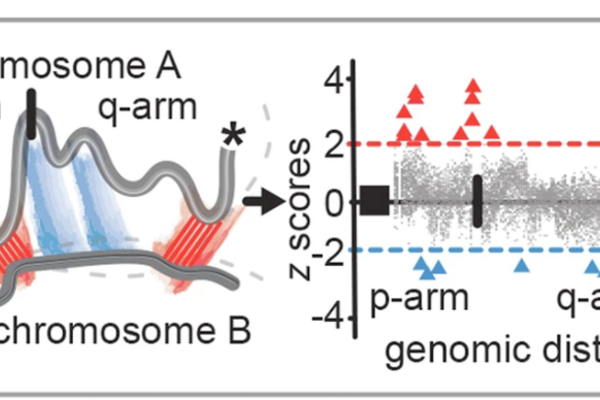Main Second Level Navigation
Breadcrumbs
- Home
- About
- News & Events
- News
- Medical Genomics Research Spotlight: Get to Know Dr. Raymond Kim
Medical Genomics Research Spotlight: Get to Know Dr. Raymond Kim

Dr. Raymond Kim is a Medical Geneticist and hereditary cancer syndrome researcher. He is the Medical Director of Cancer Early Detection at the Princess Margaret, University Health Network, and a staff physician at Mount Sinai Hospital and the Hospital for Sick Children. Dr. Kim’s research employs technologies like cell free DNA (cfDNA) and whole exome sequencing (WES), with the overarching goal of advancing oncology diagnostics and therapeutics towards precision care, often through application of these genomics technologies. He chairs the CCMG Canada-wide Cancer Genetics and Genomics (C2G2) community of practice and leads the Ontario Hereditary Cancer Research Network (OHCRN) at the Ontario Institute for Cancer Research (OICR).
As a guest lecturer in the M.H.Sc. in Medical Genomics program, Dr. Kim gives key insights into the genetic underpinnings of hereditary cancer syndromes. In the course MMG3001Y: Advanced Human Genetics, he emphasizes the importance of germline genetic testing, since test results often affect cancer surveillance strategies, surgical management, and eligibility for clinical trials. His lecture spans hereditary cancer syndromes including breast, ovarian, endometrial, colorectal, and prostate cancer, Li-Fraumeni syndrome, Lynch syndrome, and Von Hippel-Lindau syndrome. Importantly, his lecture describes how hereditary cancers display incomplete penetrance and variable expressivity, meaning not all mutation carriers will go on to develop malignancies, and two individuals with the same mutation can sometimes go on to develop different disease manifestations.
As a Medical Geneticist, Dr. Kim works mainly with adult populations, making diagnoses of inherited conditions often through genetic testing of the germline. His clinical duties are very collaborative, and he works with a team of genetic counsellors to arrange genetic testing on patients. Importantly, he notes that he also follows “rare [disease] patients longitudinally, because they are a little bit orphaned from the rest of the medical system, and so they don’t have many specialists that can take care of their complex needs.” A particular interest of Dr. Kim’s is the transition of care for patients coming from pediatric care and entering adulthood: “around the time when patients turn 17 or 18, they require a little bit of adjusting to the adult health care system because they’re used to dealing with specialists who know their condition well.” He continued, “Because they are 18, they’re considered an adult [by the medical system], but right now the system is not well geared to accommodate all of their medical and psychosocial needs.” For this reason, Dr Kim has a special interest in developing an “effective pathway” for these patients to transition out of pediatric care into the adult health care system.
When it comes to the cancer genetics in Canada, many institutions across the country encounter common challenges, and so the CCMG Canada-wide Cancer Genetics and Genomics (C2G2) community of practice was established to enable better collaboration: “It stemmed originally from tumour testing and ovarian cancer and BRCA1 and BRCA2 [genetic testing] that the gynecologic oncologists were very interested in, and then we realized that there was no real community for cancer genetics for us to tap into in Canada.” From a roadmap document produced in collaboration with Gynecologic Oncology of Canada, the cancer genetics working group was born, which over time has “morphed into a community of practice because it involves so many other stakeholders.” The C2G2 community of practice began collecting data on cancer genetics conditions from institutions across Canada: “What we did was create surveys about a few times a year on common questions that we had for certain cancer genetics conditions, and I would send the survey out, and present the data.” These surveys included an array of questions such as “how are you testing patients with prostate cancer?” And “how are you dealing with their genetic mutations?” Or “What research projects are currently going on across Canada as related to cancer genetics?” The community of practice thus provided a forum for people to get together and has grown over two years from its inception as a working group of 15-20 individuals to a community of practice comprising approximately 300 members. Many members, including Raymond, who chairs the group, are also partners in the cfDNA in Hereditary And High-Risk Malignancies (CHARM) consortium; a multi-institutional research initiative that leverages cell free DNA to improve clinical management of hereditary cancers.
From genomic and epigenomic data analysis of tumour tissues and longitudinal plasma samples from hereditary cancer patients, the CHARM consortium aims to better understand how cell free DNA can detect cancer earlier, characterize cancer subtypes, and thus inform clinical management strategies. Unlike other methods like biopsy, cfDNA is non-invasive, requiring only a blood draw, and can be employed in both the hereditary cancer screening and prenatal testing contexts. Dr. Kim recalls first hearing of cfDNA technology from his prenatal geneticist mentor Dr. David Chitayat: “David had called me one day and said, ‘you know Raymond, there is this technology that we’re using in pregnant women, non-invasive prenatal testing, but it’s detecting cancer early in some of these women, because the cancer is secreting DNA into the maternal blood.’” After learning about it, Dr. Kim considered the applications of this technology for “gene carriers [for] hereditary cancer, [who] throughout the majority of the first part of their life are generally cancer-free, and then develop pre-cancerous lesions that shed DNA into their blood.” Hereditary cancer gene carriers are often told they will develop cancer but are not told when. Many will undergo preventative organ removal through surgeries, although a number of these carriers may never go on to develop cancer and could have avoided or delayed these preventative surgeries. Dr. Kim saw how cfDNA could be applied to better understand the risk-level and prognosis in these situations: “We are supposed to figure out those carriers [who won’t develop cancer] versus those carriers who are going to develop cancer, and we think cell free DNA can do this.” Initially focused on the use of cfDNA for identification of Lynch syndrome and BRCA1/2 breast and ovarian cancer testing, the CHARM consortium has since received additional funding, which has allowed the group to target other hereditary cancers such as Li-Fraumeni syndrome and neurofibromatosis: “[cfDNA] is proving to be quite a useful tool, and we’re hoping that we can develop a prospective trial on whether or not we can use this in clinical care.”

Dr. Kim’s scientific portfolio extends beyond his involvements with the CHARM consortium and the C2G2 community of practice. He is a very active cancer genetics researcher, and has led ground-breaking projects in data sharing, precision oncology, and gene discovery. Recently, Raymond used machine learning to learn more about Von Hippel-Lindau (VHL) disease, a hereditary cancer syndrome which is complex to diagnose and difficult for clinicians to treat due to the rarity and diversity of VHL patients. His 2022 publication outlines the machine learning technique his group used to learn more about Von Hippel-Lindau, called ‘unsupervised clustering’, and discusses the group’s work creating the largest open-access database on VHL genotype and phenotype data, which is manually curated and can be accessed via the Clinical Interpretation of Variants in Cancer (CIViC) interface.
For women with high-grade serous ovarian cancers (HGSOCs), Dr. Kim describes how tumour testing is used to determine the types of genetic changes that are driving the tumour. This was successful in qualifying some of these women for precision cancer therapy: “By looking at the genetic changes that are responsible for HGSOCs, we can select those individuals that will benefit from certain types of precision cancer therapies.” Dr Kim continued, “The one that is used predominantly in serous ovarian cancer is something that’s called a PARP inhibitor.” He explained how in these PARP inhibitor responsive cases, the tumour cells are targeted using a very precise cancer mechanism, which unlike more broad-based chemotherapeutic approaches, leaves non-cancerous cells untouched, only killing the cancerous ones. He hopes that creations of hereditary cancer registries like the OHCRN will fuel more clinical trials for precision cancer therapies.
In terms of gene discovery, Dr. Kim has done important work to elucidate the complex inheritance patterns of peripheral nerve sheath tumour conditions schwannomatosis and neurofibromatosis – something very complicated and previously poorly understood. From exome sequencing in a Noonan syndrome (NS) patient – a sister condition with clinical manifestations of schwannomatosis – Dr. Kim found a variant in the LZTR1 gene which provided new evidence that NS patients with LZTR1 pathogenic variants should be assessed for schwannomatosis: “For LZTR1, what we are finding is that bi-allelic [or homozygous] mutations in LZTR1 result in Noonan syndrome, and mono-allelic or heterozygous variants in LZTR1 result in schwannomatosis.” He continued, “in our patient, [and] when you dig a little bit deeper and look at all the cases, we also find patients who are heterozygous for LZTR1 and have schwannomatosis and elements of Noonan syndrome – so this LZTR1 gene is functioning very unusually […] and this is very commonplace of the newer genes that don’t fall under a classical Mendelian inheritance, [which is] what we found in [our patient].” His findings also have implications for neurofibromatosis, a more common genetic condition affecting peripheral nerve sheaths.
As head of the Provincial Genetics Program (PGP) at Ontario Health, Dr. Kim works with expert groups to advance the implementation of genetic testing and care delivery for patients with genetic conditions across Ontario. Currently, expert groups exist for cardiac, neurodevelopmental, and neurogenetic conditions. Ontario Health plans to extend the PGP to include an additional three expert groups next year, and another six the following year. We recently featured Medical Genomics M.H.Sc. alumnus Luis Peña Martinez for his work as senior specialist of this program.
Dr. Kim is passionate about precision oncology and the application of novel genomics technologies like cfDNA for hereditary cancers and beyond. He feels there are knowledge gaps among clinicians and patients alike regarding genetic testing, especially since “no field in medicine is moving as fast as genetics and genomics, and within genetics and genomics, cancer is moving the fastest.” This is the reason why Dr Kim wants to push for more ongoing education in the oncology community, and this is also why he really values the contributions of genetic counsellors, Medical Genomics graduates and others in educating the patient population.
We wish Raymond the best in his clinical practice and research going forward and thank him for the significant contributions he has already made to the field of precision oncology.


